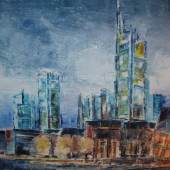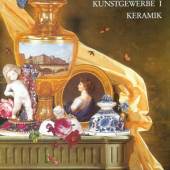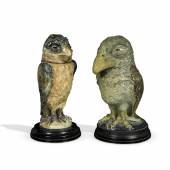Bernard Leach
CENTURY OF CERAMICS Made in Britain, Sotheby’s London, 13 September 2017
-
Auktion13.09.2017
A further highlight is a brilliant Emerald Green Footed Bowl (est. £12,000-18,000), once again demonstrating captivatingly rich colours, and her characteristic bronzed rim.
The sale also includes works by HANS COPER who worked with Rie as her studio assistant after arriving in Britain from Germany. Like Rie, Coper’s ceramics are celebrated in museums and galleries across the world.
Restored 'Thistle' Form, circa 1970 (est. £3,000- 5,000) displayed alongside Three Bowls made by Rie in 1949 (est. £4,000- 6,000).
EWEN HENDERSON was one of the most original and pioneering potters of the Post-War period, focusing on textures and colours that were inspired by his love of the natural world and insights as a painter. Henderson moved clay into a new expressiveness – calling it ‘fluxed earth’ and stretching it into complex hand-built forms. Having studied in Camberwell College of Art under Hans Coper, Lucie Rie and Colin Pearson, he later had a distinguished teaching career and is represented in the Victoria & Albert Museum, London, Museum of Modern art in Tokyo, Australian National Gallery, Canberra and New York’s Metropolitan Museum of Art. Together with his wife Kay, the ceramicist spent many years building up a sculpture garden at their house in North London.
"I was seduced by the alchemy of change where you take a material ... and it is transmogrified into something else."
Untitled (est. £3,000-5,000), an impressive sculptural piece, is one of the most important examples of Henderson’s work ever to appear at auction. Using a technique involving an irregular patchwork of different types of clay, Henderson creates an almost Cubist ‘collage in space’ – a multiplicity of textures, edges and space infused with a highly-charged energy.
JAMES TOWER is widely regarded as one of the most distinctive figures in post-war British ceramics. His works stand out for their dramatic and playful visual effects, along with the lyrical and subtle integration of references to nature and the cosmos into an essentially abstract language of form and surface decoration.
I look to the strong English tradition of absorption in landscape and organic forms, the search to find a poetic metaphor for landscape, sea and weather, to try and translate the ephemeral into the permanence of terracotta and glaze.”
Teaching at Bath Academy of Art, Corsham brought Tower into contact with some of the pioneering painters of post-war abstraction, including William Scott, Peter Lanyon and Howard Hodgkin, and as a potter he showed his work alongside Bernard Leach and Lucie Rie, contributing to a re-definition of modern craft. Large Bowl, 1980 (est. £2,000-3,000) encapsulates the painterly surfaces of the artist’s sculptural shapes.
Welsh studio potter ELIZABETH FRITSCH’s hand built painted pots are often influenced by music, painting, literature and architecture. Fritsch studied harp and then piano at the Royal Academy of Music, but later took up ceramics under Hans Coper and Eduardo Paolozzi at the Royal College of Art from the late 1960s. Her distinctive flattened, almost two dimensional, stoneware works are coil built and carefully smoothed with rhythmic geometric patterns hand painted in slips dancing like musical notation across the front surfaces. Blue and White and Black Cubist Pot (est. 2,500-3,500) and Untitled (£3,000-5,000) will be offered in the auction.
Recognised on both sides of the Atlantic as one of the leading living potters JOHN WARD’s stylish contemporary pieces pay homage to the idea of the ‘vessel’. He believes in “form above all, but expressed through light and colour”, and his simple geometric designs serve to enhance this. Working from his studio in rural Wales near the sea, the subtlety and tactile nature of his works conveys a beautiful lightness. Ward will be represented in the sale with this Vase (est. £700-1,000).
An innovative contemporary potter, NICHOLAS HOMOKY discovered black inlaid drawing on porcelain in the late 1970s – using the bold black patterning as a way of uniting linear drawing with clay. Centered on the vessel – which is seen primarily as a visual object – clarity of line and form are his chief concerns, resulting in precise and highly finished works.
“My work attempts to close the gap between the innocence of Alfred Wallis and the purity of Ben Nicholson”
Deconstruction is also a key element and in this striking Small Bowl (est. £300-500) the representation of a teapot plays with our assumptions about a familiar, everyday object, questioning its function.
An artist that needs no introduction, GRAYSON PERRY is celebrated not only as one of Britain’s most lauded living artists but also as one of its greatest and most challenging minds. At the heart of his output stands the key theme of ceramics, the medium that rocketed him into the limelight.
“What’s brilliant for me about ceramics is the range of techniques – you have everything a painter has in a way, but also most of what a sculptor has and all those very particular techniques and effects you can only get with ceramics. It’s endlessly adaptable.”
Appearing for the first time at auction Men Have Lost Their Spirits, circa 1988 (est. £20,000-30,000) is a hand-built, sculptural work in the form of a classic vase that was made as a showpiece. Acquired directly from the artist in the 1980s, it has been unseen for almost thirty years.
“Death and pottery have long gone together, and the way urns reference death is quite common. Pots are containers but they also have an anthropomorphism, with their necks, shoulders, bellies and feet.”
-
Fayence u. Keramik - Barrock Seit dem 17. Jh. verlagerte sich der Schwerpunkt der Fayence- und...
-
13.09.2017Auktion »
Sotheby’s London, 13 September 2017

















